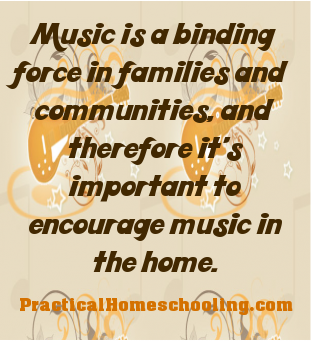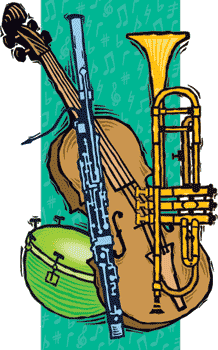 When my twin daughters were in the first grade I would escort them every other Wednesday to their Brownie meetings at the new local elementary school. I would walk with them from the front entrance doors to the far end of the school where the troop met. On the way, I enjoyed gazing into the classrooms to see how things looked "on the other side." We had just begun our homeschooling adventure and although I was confident in my decision to do so, I still had reservations on my ability to supply my children with all areas of study. Spying the music room, I peered in to see pretty posters on the wall with dancing key signatures and music symbols. There was an open area in the front for circle dances and simple ensembles with glockenspiels, drums, and tambourines.
When my twin daughters were in the first grade I would escort them every other Wednesday to their Brownie meetings at the new local elementary school. I would walk with them from the front entrance doors to the far end of the school where the troop met. On the way, I enjoyed gazing into the classrooms to see how things looked "on the other side." We had just begun our homeschooling adventure and although I was confident in my decision to do so, I still had reservations on my ability to supply my children with all areas of study. Spying the music room, I peered in to see pretty posters on the wall with dancing key signatures and music symbols. There was an open area in the front for circle dances and simple ensembles with glockenspiels, drums, and tambourines.
I had created similar small ensembles in my music studies during college and presented similar activities to children in my part time work as a Kindermusik instructor. I entered music education because I have an innate belief that music is not only an enjoyable pastime, but also perhaps even an internal need as strong as language itself, providing a link to our furthest ancestors. Looking at this well-supplied classroom I wondered how I would be able to teach my children music and carry on this human tradition without the resources a fully funded music program can provide.
As my thoughts pondered this concern, I realized that it is possible the training I received in music education might actually run counter to the natural place music should play in our community, family, and church. Music is not a subject to be packaged and be presented only at a set time and age group. Music was intended to enhance and bring expression to the beauty, sorrow, wonder, and worship in all of our lives. This is the place music seemed to hold in the lives of those in the past, but is now often absent in our modern world.
Laura Ingalls Wilder's "Little House" series shows what life was like prior to formal music education in the school. Throughout this series we read of the music in her life. Wilder recalls the sound of her pa's fiddle, the lullabies of her mother, and the toe-stomping dances of Mr. Edwards. Her feelings toward singing are expressed in By the Shores of Silver Lake where she writes:
Laura did not know whether or not she wanted to be settled down. When she had schooling, she would have to teach school, and she would rather think of something else. She would rather sing than think at all.
Clearly singing was not a subject in school to be studied by the average child. It was a break from the realities of life. She could sing anywhere, anytime. Music was central to many of her most cherished memories of childhood, bringing joy to even the harshest winters and longest trips.
Traditionally, the music of the common man was handed down from parent to child even more often than from master to apprentice. It passed the dreary day in the fields, entertained the children in the cold, passed on tales of old, and created the perfect atmosphere for worship.
 However, in modern times music has become as sterile as any other form of education. This is not to suggest that there isn't a place for formal music study. On the contrary, there is ample evidence to suggest formal study can provide children with many benefits in learning and brain development. But if music has become only a method used to increase scores, provide a "taste" of this or that, or produce a cute little winter program for the parents, we are missing the most important aspect of this education: the pure love and enjoyment it brings to the human soul.
However, in modern times music has become as sterile as any other form of education. This is not to suggest that there isn't a place for formal music study. On the contrary, there is ample evidence to suggest formal study can provide children with many benefits in learning and brain development. But if music has become only a method used to increase scores, provide a "taste" of this or that, or produce a cute little winter program for the parents, we are missing the most important aspect of this education: the pure love and enjoyment it brings to the human soul.
With few exceptions, every human being is born with basic musical potential. This potential can only be realized when given attention, preferably during childhood when not only are our brains at their most receptive to learning, but the customs of our culture are most firmly established. It is unlikely that Caroline Ingalls was formally trained in music. However her songs inspired a love within her child that would last a lifetime and be handed down to the generations that followed. Charles Ingalls did not play Mozart on his fiddle and expect children with little experience in music to be able to follow the complicated themes presented. Instead he bellowed out a chorus of "Billy Boy" and "Old Dan Tucker." Music was a way to relax, enjoy family and good friends, or join voices together in worship.
The loss of a connection through music is probably the most obvious symptom of what happens when children have the media and school replace their families as the focus of their lives. To rediscover the social and expressive value of traditional folk music, we must consider what made the music of Laura Ingalls Wilder so enjoyable that all ages would wish to sing it repeatedly. In contrast, modern music tends to last less than a decade, includes obvious generation gaps, and is usually only sung quietly to the radio. Without taking time to consider this we may find ourselves humming tunes our children will one day scoff at.
The strength of these enduring folk songs was likely due to their universal appeal, simple words to remember, and ease of rhythm and melody to recreate in any situation. The tune of "There was a man lived in the moon, lived in the moon, lived in the moon... " is catchy alone and does not require the rolling background chords to be complete. You can find any table and tap along. The lyrics are simple enough for a young child to join in and yet to be remembered by adults years after their youth has past. It's an appropriate song for washing dishes, riding in the car, or dancing in the living room. In other songs you meet people from a time gone by, as in "Polly-Wolly-Doodle" with its clever use of word play repeated throughout the song, making it delightful to repeat time and again.
Though once sung by all ages, tunes like these are rarely heard anymore outside of preschool programs. In fact, many people do not remember even the choruses, let alone the entire song. Yet these are a sample of the very songs that once helped bind a community together. A family get-together or church gathering often included music as a form of entertainment with grandparents singing right along with the youth. Such timeless folk songs are no longer found in most families and only in a few churches outside of the service. However, there are many resources available which can help any family recapture this joyful pastime.
Parents wishing to bring spirituals and folk music back to life in their homes can find collections such as the arrangements by Jean Shafferman and Anna Page. This series is an ideal selection for families with children in kindergarten through elementary. All books can be purchased with an accompaniment CD. The collection includes Bible Stories & Songs of Praise, Treasures New and Old, or I Sing, You Sing, by Sally Albrecht and Jay Althouse. For the slightly older audience there is the new "Ready To Sing" songbook series by Althouse. This series currently includes Ready to Sing Folk Songs and Ready to Sing Spirituals that include a book and accompaniment CD that will have your family enjoying such music as "Oh, Susanna," "Li'l Liza Jane," "Good News!" and "Amazing Grace." This is just a sample of the resources out there for anyone caring to look.
Parents that did not grow up in a musical environment may not yet have the confidence to present music to their children alone and seek outside help. General music courses, such as Musikgarten and Kindermusik are now available, particularly for younger children, and many include family activities. Including parents is critical to the success of any program wishing to reincorporate music in its proper place in the family. A child can learn pitch and rhythm from a formal setting but he will not learn the natural importance of music in every day life from a structured classroom setting. That is a role for the parent.
Perhaps that elementary school music room has pretty charts, expensive xylophones and a professionally designed curriculum to train children to listen with a critical ear and sing in tune. My children have something much more important. They have a "Ma" and a "Pa" and a world full of music to fill their lives.